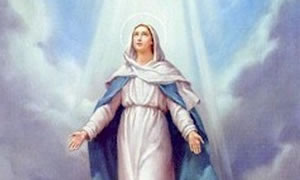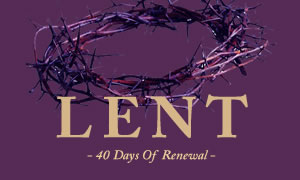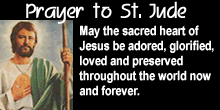


 Catholics and all Christians believe that the Body of Jesus Christ is now in heaven. This doctrine is called the Ascension and is explicitly revealed in the Bible. All Christians believe, too, that the bodies of the just will be united to their souls at the end of the world and be glorified in heaven after the manner of the Risen Body of Christ. This is also revealed explicitly in the New Testament. It follows, therefore, that the bodies and souls of the departed saints are now separated, that their souls are in heaven and their bodies in the grave. Christians of every conceivable denomination are agreed on these two dogmas unanimously.
Catholics and all Christians believe that the Body of Jesus Christ is now in heaven. This doctrine is called the Ascension and is explicitly revealed in the Bible. All Christians believe, too, that the bodies of the just will be united to their souls at the end of the world and be glorified in heaven after the manner of the Risen Body of Christ. This is also revealed explicitly in the New Testament. It follows, therefore, that the bodies and souls of the departed saints are now separated, that their souls are in heaven and their bodies in the grave. Christians of every conceivable denomination are agreed on these two dogmas unanimously.
After that, however, Protestants and Catholics disagree. We Catholics believe that the body of the Blessed Virgin Mary is also in heaven. We call this doctrine the Assumption. By it we hold that the glorification of the flesh, which will take place for us only at the end of time, was granted to Mary at the end of her earthly life.
We believe, therefore, that the bodies of both Jesus and Mary are now in heaven. There is, however, this difference: Jesus arose from the tomb and ascended into heaven by his own power, whereas Mary's body was taken up to heaven by the power of her Son. For that reason we use two different words: the Ascension of Christ and the Assumption of Mary.
Implicit in Bible
The Bible nowhere mentions explicitly this glorification of Mary's Immaculate body. That it has been revealed by God is nevertheless certain; otherwise it could not have been defined as a dogma of faith, A public revelation of the Assumption must have been made to the Apostles, or at least to one of them, because public revelation closed with the death of the last Apostle. There are, however, several implicit revelations of the Assumption in the Bible. The most important texts are: Gen. 3:15; Lk. 1:28; Apoc. 12:1-2.
The Extent of the Magisterial Teaching
In defining the Assumption as a revealed dogma, Pope Pius XII did not infallibly answer all the questions that relate to the “where, when, and how” of the Assumption. For example, we do not know how old Mary was and whom she was with at the time. Also, the Holy Father did not attempt to resolve the controversy as to whether she was in Ephesus or Jerusalem, as there was no mention of where she was at the time of her Assumption. In addition, Pope Pius XII’s definition said nothing about Mary’s mediation, her queenship, or other privileges.
And significantly, Pope Pius XII left open the question of whether Mary “died.” Note that the definition intentionally uses the ambiguous phraseology, “having completed the course of her earthly life.” Some maintain that she did not die, because her Immaculate Conception freed her from the effects of original sin, including death. Others maintain that it would have been fitting for her to die, so that she could be fully conformed to Christ her Son. Thus she freely accepted death in order to more fully associate herself with her Son’s redemption (cf. Vatican II, Lumen Gentium, no. 58). It is important to note in this regard that if Mary did die before being assumed into heaven, it was a voluntary death and did not involve the bodily corruption that usually accompanies death as a consequence of original sin.
The Assumption in Divine Revelation
In addition to Genesis 3:15, there are several other Scripture passages that point to the Assumption of Our Lady. For example, there is Luke 1:28, since her bodily assumption is a natural consequence of her being “full of grace.” Other passages include Revelation 12:1, in which Mary’s coronation implies her bodily assumption, and 1 Corinthians 15:23 and Matthew 27:52-53, which support the possibility of a bodily assumption. And lastly there is Psalm 132:8, which provides: “Arise, O Lord, into your resting place: you and the ark which you have sanctified.” Mary is the new Ark of the Covenant, who physically bore the presence of God in her womb before bearing Christ to the world.
The Assumption is also witnessed by sacred Tradition. For example, St. Gregory of Tours (d. 593) wrote: “The Lord commanded the holy body [of Mary] to be borne on a cloud to Paradise where, reunited to its soul and exalting with the elect, it enjoys the everlasting bliss of eternity.” The doctrine was also explicitly taught by Church Fathers such as St. Germain of Constantinople, St. Andrew of Crete, and St. John Damascene.
There is a maxim that provides “Lex orandi, lex credendi” (“the law of praying is the law of believing”). This maxim summarizes the truth that the liturgical life of the People of God plays an important role in preserving and celebrating the Faith of the Church. Already in the sixth century there were liturgical feasts dedicated to Mary’s Assumption. And indeed, from the 13th century on, the doctrine of Mary’s Assumption was taught with near unanimity in both the west and east. And the Rosary, which includes a decade on the Assumption, has been an important part of Catholic piety since the early 13th century.
Why a Dogma of the Faith?
It is fair to ask why it was necessary to have the dogma defined. After all, the doctrine of the Assumption was already accepted throughout the Church, and, unlike the Immaculate Conception before it was solemnly defined in 1854 by Pope Pius IX, the teaching of the Assumption was never the subject of controversy.
However, following the definition of the Immaculate Conception, the Vatican received millions of petitions from bishops, priests, religious, and laity asking for the definition of Mary’s Assumption. The Popes after Pius IX encouraged the movement for the dogmatic definition. Finally, Pope Pius XII in 1946 sent a letter entitled Deiparae Virginis Mariae to all the bishops in the world in which he asked them whether
(a) the teaching can be proposed as a dogma and
(b) whether the people desired it.
The result was staggering. Out of 1232 bishops, 1210 answered “yes” to both questions. Such near unanimity among the bishops regarding doctrinal pronouncements is almost unprecedented in Church history. And so the theological principle used to justify the proclamation of the dogma was the uniform faith of the whole Church. In his dogmatic pronouncement, the Holy Father appeals to the Church’s teaching authority and the constant faith of the Christian people, which that same teaching authority “sustains and directs” in proclaiming Mary’s bodily Assumption to be a revealed truth (cf. Vatican II, Lumen Gentium, nos. 12, 25).
The solemn proclamation of God’s word has historically been an occasion of tremendous joy and grace in the Church. One calls to mind, for example, the celebration of the faithful when Mary was declared “Mother of God” (theotokos) at the Council of Ephesus in 431 or, in Old Testament times, the tears of the Israelites when Ezra read the words of the law to them after their return from exile (cf. Neh. 8:5-12).
At the close of Munificentissimus Deus, Pope Pius XII exhorts the faithful as follows:
[T]his solemn proclamation and definition of the Assumption will contribute in no small way to the advantage of human society, since it redounds to the glory of the Most Blessed Trinity, to which the Blessed Mother of God was bound by such singular bonds. It is to be hoped that all the faithful will be stirred up to a stronger piety toward their heavenly Mother, and that the souls of all those who glory in the Christian name may be moved by the desire of sharing in the unity of Christ’s Mystical Body and of increasing their love for her who in all things shows her motherly heart to the members of [Christ’s] Body... In this magnificent way, all may see clearly to what a lofty goal our bodies and souls are destined. Finally, it is our hope that belief in Mary’s bodily Assumption into heaven will make our belief in our own resurrection stronger and render it more effective.
Reasons for the Assumption
Ancient belief in the Assumption was based on the Christian conviction that Christ willed his holy Mother to participate in all his prerogatives. Therefore he associated her in his own glorification by an anticipated resurrection.
The corruption of the grave is a punishment for sin (Gen. 3:19). Our flesh is a "flesh of sin" (Rom. 8:3). Through the desires of this flesh the majority of our sins are committed. In Mary, however, there is not the slightest stain of sin. By her Immaculate Conception and fullness of grace she was entitled to immunity from corruption in her body. The principle of corruption which we bear within us did not exist in her. "Flesh and blood," says the Bible, "cannot possess the kingdom of God" (I Cor. 15:15). Even the bodies of the saints do not deserve to enter the kingdom of God. They must first be renewed by the hand of God. But Mary's body - Immaculate, pure, sinless -is consequently incorruptible.
From the first moment of her conception the state of the Blessed Virgin Mary was analogous, but superior, to the state of Adam and Eve before the Fall. Had they not sinned they would not have heard the divine malediction: "Dust thou art, and unto dust thou shalt return" (Gen. 3,19). Doesn't justice therefore demand that Mary be preserved from a malediction never merited by her?
Mary's Immaculate Body was, in a sense, the origin of sanctification of all mankind. Her flesh was used to form the flesh of her Son; the flesh which he used on the Cross to destroy death and sin, and which he gave to us that we might rise from the dead. Was this flesh, Mary's flesh, Christ's flesh, the instrument of our redemption and resurrection, to be subject to the corruption of the grave?
"The womb that bore Jesus Christ, the hands that caressed him, the arms that embraced him, the breasts that nourished him, the heart that so loved him - it is impossible to think that these crumbled into dust" (Father Canice, OFM Cap.).
Christ's perfect victory over Satan included victory over sin and death. But Mary, the Mother of God, was most intimately associated with Jesus in his victory over Satan. She not only furnished the flesh which Christ sacrificed for our Redemption, but she also had a definite role of cooperation in this Redemption. She was associated with him in the different parts of his triumph. Hence she was associated with him in his victory over death by her anticipated resurrection and Assumption. This argument is used by Pope Pius IX in the Bull Ineffabilis Deus.
In the virginal conception and birth of his Son, God performed an absolutely unique miracle. This miracle was an act of divine respect for the flesh of the Mother of God. Against all the laws of nature he preserved the corporal integrity of his Mother. Would he later allow that Immaculate flesh to suffer the immeasurably greater lesion of the corruption of the grave?
By a special favor granted to her by her Lord and Savior, Mary indeed did triumph over sin in her Immaculate Conception. Corruption of the body is a result of original sin. Because Mary was preserved from original sin in her Immaculate Conception, and since she sustained the fullness of grace given to her by God (cf. Lk. 1:28), Our Lady could not have experienced the consequences of original sin. So Mary also triumphed over the bodily corruption of death in her glorious Assumption.
It is a basic principle of Catholic teaching that all the prerogatives and glories of Mary are because of Jesus Christ. His divine dignity presupposes and demands such perfection in his Mother. The flesh of Mary was the Flesh of Christ; and Christ owed it to himself to preserve from dissolution the body that had served to form his own Body. Mary's body, like her soul, had to be sinless and undefiled. The humiliation of the Mother would have been the humiliation of the Son.
Silence of Early Centuries
The first person known to have asked what happened to Mary's body was St. Epiphanius. He was a 4th century Bishop, close to the scene of events, who had devoted himself seriously to the study of Mary's death. On the occasion of the controversy against the Antidico-marianites, opponents of Mary's virginity, he apparently had no knowledge of even the existence of a tradition concerning the end of Mary's life. In fact, he seemed to be of the opinion as are many mariologists today, that Our Lady did not die. Here are his exact words:
"The Sacred Scriptures do not say that Mary remained in the house of St. John, and the probable reason for the silence of Holy Writ concerning Mary's later life may be found in the fact that her life was so completely heavenly and wonderful that mankind could not possibly have borne the spectacle. Perhaps the Apocalypse (12,13) would show by the woman who was snatched from the dragon, that Mary escaped death. If she did die, her death was kept hidden, that people might not think too carnally about Mary."
Origin of Feast
From the middle of the 5th century a feast called "Commemoration of the Mother of God" was celebrated on August 15th in a shrine located near Jerusalem. Near the end of the 6th century this became a feast commemorating the end of Mary's sojourn on earth and was called the "Dormition of Our Lady." In the beginning of the 8th century Pope Sergius introduced the feast into Rome together with three other feasts of the Blessed Virgin.
From Rome it spread rapidly throughout western Europe. It was Pope Hadrian who, at the end of the 8th century, gave it the name of the "Assumption of St. Mary." The Greek Church became interested in this question long before the Latin Church did. Both Greek and Latin writers, however, readily acknowledged their ignorance of the way in which the Blessed Virgin Mary had left this world.
Development and Definition
When Pope Pius IX defined the dogma of the Immaculate Conception in 1854, it drew attention to the possibility of a dogmatic definition of the Assumption. Both are truths not found explicitly in the Bible. Many began to petition the Apostolic See for its immediate definition. Between 1849 and 1940 more than 2,500 such petitions were received from bishops and superiors of religious orders. These represented 73% of the Catholic hierarchy.
On May 1st, 1946, Pope Pius XII sent an Encyclical Letter ("Deiparae Virginis") to all the bishops of the world asking them to make known to him the belief and devotion of themselves, their clergy, and their people regarding the Assumption. 1185 bishops answered that the dogma could safely be defined, and only 16 questioned the advisability of the proclamation at that time. It was therefore a quasi-unanimity. On November 1st of the Holy Year, 1950, the day after the closing of the 8th International Marian Congress, held that year in Rome, Pius XII solemnly defined the dogma of the Assumption of the Blessed Virgin Mary into heaven. This great event took place in the Piazza of St. Peter's in the presence of 40 Cardinals, 500 bishops, thousands of priests, and close to one million lay persons. The exact words of the dogma of faith definition, extracted from the Bull "Munificentissimus Deus," were:
"Mary, having completed the course of her earthly life, was assumed body and soul into heavenly glory."
Just as Mary received Christ on earth, so Christ in turn received Mary in heaven. Having deigned to descend to her, it was fitting that he should raise her to himself in his glory. The place of the Mother of God is in the splendors of eternal glory and not in the gloom of the sepulchre.
"The Virgin, who gave history its impetus, was herself soon detached from it, to become instead an emblem of history's goal." — Jean Guitton
Prayer of Pope Pius XII
"O Immaculate Virgin, Mother of God and Mother of Men, - we believe with all the fervor of our Faith in your triumphal Assumption, both in body and soul, into heaven where you are acclaimed as Queen of all the choirs of angels and all the legions of the Saints; and we unite with them to praise and bless the Lord Who has exalted you above all other pure creatures, and to offer you the tribute of our devotion and our love."
(from the Assumption Prayer of Pope Pius XII)
References:Rev. James M. Keane, O.S.M. - The Assumption of Our Lady


I have been thinking a great deal about my experience at Reconciliation this past Saturday. I felt an intense and unexplainable urge to go and confess my sins when I woke up that morning. I try to go every six weeks or so, but this was no routine visit to the priest for me. I needed to unburden myself of the numerous venial sins I had committed since I last participated in this Sacrament.
Purest Gold: God's Refining Fire in our Lives »
After salvation, many young Christians wonder if there's anything more to their newfound faith than just the security blanket of "being a Christian." Time and time again, God shows himself as a "refiner," and our lives are as gold. God started leading me in this study to understand what He was doing in my life, as well as in the lives of others.
Picking up my pen to write this column, I couldn’t imagine how time flies. Since the last publication of this column I have gone through a lot, especially the loss of my dear mother to whom I dedicate this article. Not only her, but seems I lost a whole generation of my close family.
How to Achieve Business Excellence »
“Do you see a man who excels in his work? He will stand before Kings; He will not stand before unknown men.” Proverbs 22:29
Spiritual Development for our Youth »
Most of us youth in today's fast moving world are easily thrown off by difficulties and worries.
The theme of conversion is a thread that runs all through Lent, but conversion takes on different aspects throughout the phases of Lent. The first two and a half weeks focused on the interior turning of hearts; the liturgy urges the faithful to reflect and examine consciences thoroughly.
Saint Josephine Bakhita »
Feast Day: February 8
Patron Saint Of: Sudan
Saint Josephine Margaret Bakhita was born around 1869 in the village of Olgossa in the Darfur region of Sudan. She was a member of the Daju people and her uncle was a tribal chief. Due to her family lineage, she grew up happy and relatively prosperous, saying that as a child, she did not know suffering.
Catholics Must Fast More Intensely This Lent»
The Norbertine Canons of St. Michael's Abbey have created this digital Lenten retreat so that you can journey through this holy season alongside them. If you want to have one of your best Lenten seasons yet, join us in our Lenten Program "The Great Fast" - https://theabbotscircle.com/the-great-fast-join
When Your Faith Is Put to the Test - Bishop Barron's Sunday Sermon»
Friends, we come now to the Second Sunday of Lent, and we’re on both dangerous and very holy ground with the first reading from the twenty-second chapter of Genesis. The ancient Israelites referred to it as the “Akedah,” which means the “binding”: Abraham binds and is ready to sacrifice Isaac at God’s command.

Copyright © 2002-2024 THE BEACON INTERNATIONAL CATHOLIC MAGAZINE. All rights reserved.
another mc.rufus interactive web design